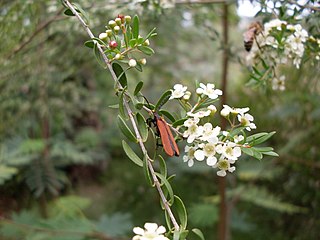
Olearia axillaris, commonly known as coastal daisy-bush, coast daisy-bush or coastal daisybush is a species of flowering plant in the family Asteraceae and is endemic to coastal areas of Australia. It is an erect, bushy shrub with densely cottony-hairy branchlets, aromatic, linear to narrowly elliptic or narrowly lance-shaped to egg-shaped leaves with the narrower end towards the base and small white and yellow, daisy-like inflorescences.

Pultenaea muelleri, commonly known as Mueller's bush-pea, is a species of flowering plant in the family Fabaceae and is endemic to Victoria, Australia. It is a dense shrub with hairy stems, elliptic to narrow egg-shaped leaves with the narrower end towards the base, and yellow and red flowers arranged singly or in pairs on the ends of short side shoots.

Micrantheum hexandrum, commonly known as box micrantheum, is a species of flowering plant in the family Picrodendraceae and is endemic to eastern Australia. It is an erect, monoecious shrub with oblong to narrowly lance-shaped leaves, and small white flowers with six or nine stamens. Picrodendraceae.

Micrantheum ericoides is a species of flowering plant in the family Picrodendraceae and is endemic to eastern Australia. It is a small, heath-like, monoecious shrub with linear to narrowly elliptic leaves, and small white or pinkish flowers arranged singly or in pairs.

Sannantha pluriflora, commonly known as tall baeckea, is a species of flowering plant in the myrtle family, Myrtaceae, and is endemic to continental southeastern Australia. It is a shrub or small tree with lance-shaped to elliptic leaves, and groups of two to nine white flowers arranged in umbels in leaf axils.

Prostanthera walteri, commonly known as blotchy mint-bush, is a species of flowering plant that is endemic to south-eastern Australia. It is a sprawling shrub with tangled, hairy branches, egg-shaped leaves and usually bluish green flowers with prominent purple veins arranged singly in leaf axils.

Prostanthera decussata, commonly known as dense mintbush, species of flowering plant that is endemic south-eastern Australia. It is a dense, compact, strongly aromatic shrub with egg-shaped leaves and mauve to violet flowers with yellow streaks, arranged in leaf axils near the ends of branchlets.
Micromyrtus barbata is a species of flowering plant in the family Myrtaceae and is endemic to inland areas of Western Australia. It is a shrub with small, overlapping, narrowly egg-shaped leaves and small white flowers arranged singly in upper leaf axils.

Prostanthera eckersleyana, commonly known as crinkly mintbush, is a species of flowering plant in the family Lamiaceae and is endemic to the south-west of Western Australia. It is an erect or spreading shrub with sticky, hairy branchlets, egg-shaped to elliptical leaves and blue, mauve to purple or violet flowers with maroon spots inside the petal tube.

Teucrium teucriiflorum is a species of flowering plant in the family Lamiaceae, and is endemic to arid and semi-arid areas of Australia. It is a semi-scandent shrub with many branches, linear to narrow lance-shaped or narrow egg-shaped leaves and creamy-white flowers.

Hibbertia acicularis, commonly known as prickly guinea-flower, is a species of flowering plant in the family Dilleniaceae and is endemic to eastern Australia. It is an erect or prostrate shrub with linear to lance-shaped leaves and yellow flowers arranged singly in leaf axils with the six to eight stamens joined at the base, in a single cluster.
Hibbertia araneolifera is a species of flowering plant in the family Dilleniaceae and is endemic to Queensland. It is a small shrub with wiry branches, narrow elliptic to lance-shaped leaves and yellow flowers arranged singly in leaf axils, with forty to forty-four stamens arranged around the three carpels.
Hibbertia argyrochiton is a species of flowering plant in the family Dilleniaceae and is endemic to northern parts of the Northern Territory. It is a shrub densely covered with scales and has elliptic to lance-shaped leaves, and yellow flowers usually arranged singly in leaf axils, with twenty to twenty-four stamens arranged in groups around the two carpels.

Thryptomene parviflora is a species of flowering plant in the family Myrtaceae and is endemic to Queensland. It is a slender, erect shrub with decussate, linear to egg-shaped leaves with the narrower end towards the base, and flowers with five petals and five stamens arranged singly in leaf axils.

Hibbertia glaberrima is a species of flowering plant in the family Dilleniaceae and is endemic to Central Australia. It is a glabrous, spreading shrub with oblong to lance-shaped leaves and yellow flowers borne singly in upper leaf axils, with 30 to 150 stamens arranged around three carpels.

Hibbertia huegelii is a species of flowering plant in the family Dilleniaceae and is endemic to the south-west of Western Australia. It is an erect, spreading or prostrate shrub with hairy branchlets, linear leaves and yellow flowers arranged singly in leaf axils on the ends of shoots, with fifteen to twenty-five stamens in bundles around the four or five carpels.

Leucopogon concurvus is a species of flowering plant in the heath family Ericaceae and is endemic to a restricted part of South Australia. It is a slender shrub with egg-shaped leaves, and white, tube-shaped flowers arranged along the branches.

Sprengelia monticola, commonly known as rock sprengelia, is a species of flowering plant of the family Ericaceae, and is endemic to the Blue Mountains in eastern New South Wales. It is an open or low-lying shrub with egg-shaped to lance-shaped leaves, and white flowers arranged singly in leaf axils.

Mirbelia subcordata is a species of flowering plant in the family Fabaceae and is endemic to the south-west of Western Australia. It is an erect, spreading shrub with egg-shaped to lance-shaped leaves and yellow or orange and red flowers.

Styphelia capillaris, commonly known as Horts' styphelia, is a species of flowering plant in the heath family Ericaceae and is endemic to a small area of south-western Western Australia. It is a dense, spreading shrub with narrowly egg-shaped to narrowly elliptic leaves and white flowers arranged singly or in pairs in leaf axils.

















